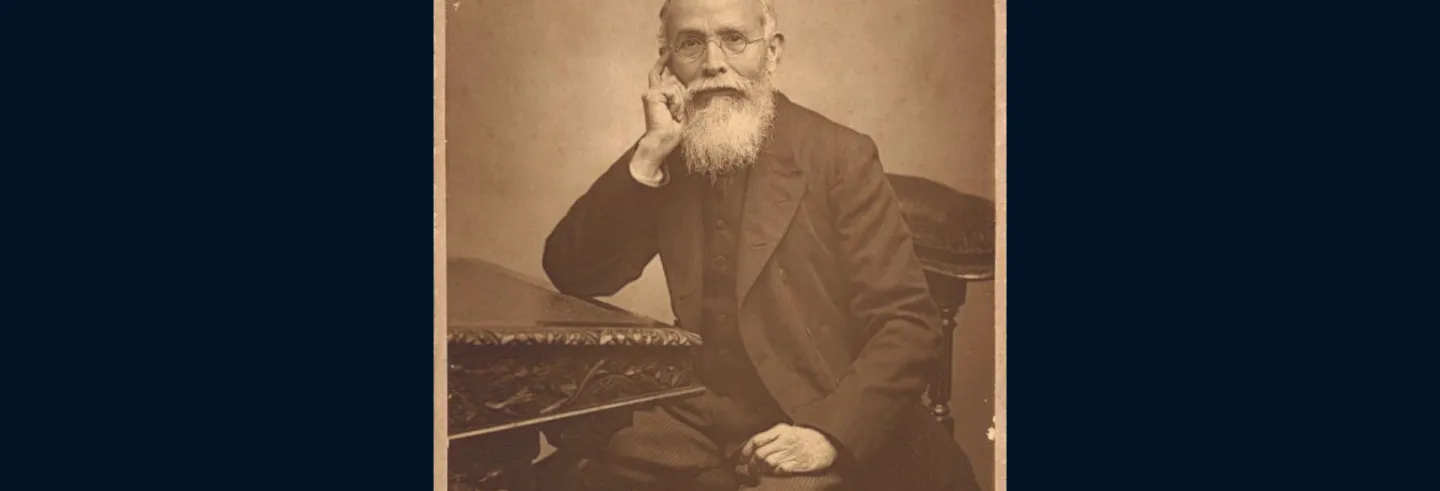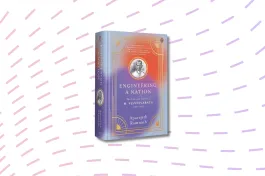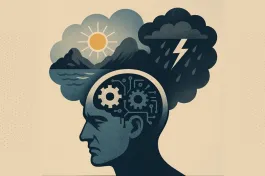The late S.R. Mehrotra, eminent historian of India's freedom movement, referred to Dadabhai Naoroji (1825-1917) as “the greatest figure in early Indian nationalism.” It is now more than 100 years since the passing of Naoroji, known as the 'Grand Old Man of India' and the 'Father of Indian Nationalism'. After Raja Rammohun Roy, Naoroji was modern India's next truly international figure. It is also useful to remember that Naoroji had guided Gandhi through his South African years. 1 On 5 July 1894, the not-yet-25 years-old Gandhi had written to Naoroji from Durban: "I am yet inexperienced and young and, therefore, quite liable to make mistakes. The responsibility undertaken is quite out of proportion to my ability [...] You will, therefore, oblige me very greatly if you will kindly direct and guide me and make necessary suggestions which shall be received as from a father to his child." (CWMG 1, 140).
Dinyar Patel, who had earlier published with Mehrotra selections from the private papers of Naoroji (Mehrotra and Patel 2016), has now written a noteworthy biography of Naoroji. It bears the mark of painstaking research and is a pleasure to read. It places Naoroji among the leading non-European 'thinkers and reformers' of the time.
This new book illustrates the importance of biography in preserving the memory of a people. Patel is insightful in observing that South Asian historical scholarship is "very prone to the vagaries of academic fashion" (Patel, 10). The issues of historical memory would be of little consequence if they were not also tied to contemporary attempts at implicit erasure of the conception of India that had moved those who struggled for its freedom.
Patel cautions us against slotting Naoroji into the pigeon-hole of economic nationalism. As he forcefully points out, economic nationalism and political nationalism at the time were "embedded in one another".
Often personalities associated with or reflecting a major historical trend get identified with a few short-hand markers to the exclusion of their other achievements. The remembrance of Naoroji in India is usually reduced to three bullet points: a founder and thrice president of the Indian National Congress; as the first Indian to be elected to the British Parliament in 1892; and for his 'drain theory', characterising the relation between India as a colony and Britain as the ruling power to explain continuing and aggravated Indian poverty. In his book, Patel cautions us against slotting Naoroji into the pigeon-hole of economic nationalism. As he forcefully points out, economic nationalism and political nationalism at the time were "embedded in one another" (83).
Patel's work, like Rustom P. Masani’s biography of Naoroji in 1938-39, recalls the vast and multifarious personal achievements and public contributions of the Grand Old Man of India. These extend from his becoming the first Indian professor (of mathematics and natural philosophy) at Bombay’s Elphinstone Institution (renamed in 1856 to its current name, Elphinstone College), to helping pioneer female education, and to his efforts for social and political reform. This was in addition to Naoroji’s institution-building efforts both in India and in England, his public, political and electoral campaigns, his academic exercises, and his journalistic ventures. There was an underlying unity between all these activities — the cause of oppressed peoples. Naoroji was what we would now be tempted to call a ‘multi-tasker’.
The making of a Grand Old Man
Masani had referred to an essay written in 1904 by Naoroji for T. P. O'Connor's journal, Mainly about People, crediting his widowed mother Manekbai, for having "made me what I am." Patel’s book delves deep into Naoroji's early education in Bombay, tracing his school education from an 'indigenous' school to an English school run by the Bombay Native Education Society, and then the Elphinstone Institution. This college, Patel observes, had between the 1830s and 1870s many Scotsmen and Irishmen of liberal ideas, many of them being heirs to the Scottish enlightenment 2 His early influences and his teachers are traced exceedingly well. Among these may be mentioned John Harkness, John Bell, Joseph Patton, and Arthur Orlebar. Naoroji's Indian teachers and mentors included Bal Gangadhar Shastri Jambhekar and Navrozji Fardunji. . Masani, in his biography of Naoroji, mentions Arthur Orlebar, professor of mathematics at Elphinstone, referring to the young Naoroji, who made an early impression on his teachers, as the "Promise of India".
Naoroji attributed the impoverishment of peasants to "bad administration" or faulty governance. It is this link that Naoroji would relentlessly pursue during the rest of his career.
In 1849, the 24-year-old Naoroji was associated, along with a dozen Elphinstonians, in the establishment of six schools for girls. The network behind this would evolve into the Bombay Association. This organisation would provide a forum for articulating suggestions and demands to improve education and governance in India. It was in a speech at the inauguration of this association in August 1852 that Naoroji attributed the impoverishment of peasants to "bad administration" or faulty governance. (Patel, 61). It is this link that Naoroji would relentlessly pursue during the rest of his career, with the remedies becoming sharper and increasingly sweeping in character.
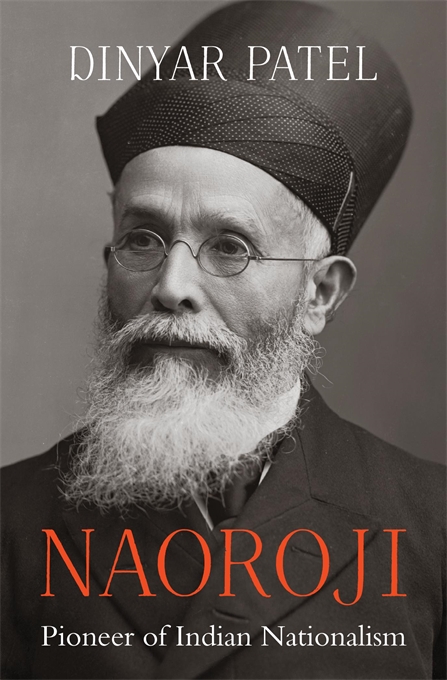
Patel delineates Naoroji's early life till his first journey to England in 1855, a few months before he turned 30. By then he was already well known in Bombay. It was during this period that Naoroji co-founded (in 1851) Rast Goftar (‘The Truth-Teller’), a Gujarati language journal devoted to social reform. Although it was focused especially on the Parsi community, the paper was pledged by Naoroji to “the service of all Indians irrespective of caste or creed.”
Naoroji’s economic and political ideas began to evolve further and he began documenting the relation between Indian poverty and British rule. The Orissa famine of 1865-67 helped develop arguments on the economic drain from India.
The next few decades were a period of multifarious activity for Naoroji. He was in 1855 to start, along with "two other Parsi gentleman," what was seen as the first Indian commercial firm based in England. Within a year or so he was appointed also as professor of Gujarati at the University College in London. Naoroji’s economic and political ideas began to evolve further and he began documenting the relation between Indian poverty and British rule. The Orissa famine of 1865-67 helped develop arguments on the economic drain from India. Critiquing data minutely, he sought correctives. For example, making a comparison of Delhi and Ludhiana statistics on sugar production per acre, he cast doubt on the credibility of the data.
Patel deals with Naoroji's very fruitful collaboration in England with Henry Fawcett, the blind economist and member of parliament, who became known for taking up Indian causes. Fawcett introduced a resolution in 1868 in the House of Commons calling for simultaneous civil service examinations in India and Britain, a cause dear to Naoroji. The resolutions became a regular feature and kept the issue alive. Fawcett also sought what became the British parliament’s Select Committee on East India Finance, to which Naoroji made a submission in the 1870s that would later become known as ‘The Poverty of India’.
Naoroji forged extensive contacts with progressive British, Irish, European and American figures [...] He sought out socialists, Irish Home-Rulers, workers and suffragists.
There is not much in Patel's work, however, about Naoroji's tenure in India as a very independent member of the Bombay Municipality (1873-1876, 1883-1885) from the very district in Bombay where he was born. (For this see Masani, 180-183.) In 1885-86 he was appointed a Member of the Legislative Council of Bombay. (This incidentally would suggest that Naoroji was associated with the statutory institutions also at the time of the formation of the Congress.) Naoroji's involvement with municipal work may be seen as an early precedent in a long line of such activity by other contemporary and later Indian nationalist figures like Surendranath Banerjea (Calcutta and North Barrackpore), C Rajagopalachari (Salem), Sardar Patel (Ahmedabad), Jawaharlal Nehru (Allahabad), T Prakasam (Rajahmundry), Subhas Bose (Calcutta), Govind Ballabh Pant (Kashipur) and K F Nariman (Bombay).
The parliamentary campaigns
At a meeting held on the retirement of Lord Ripon as Viceroy in 1884, the year before the founding of the Indian National Congress, Naoroji spoke of self-government and self-administration. After the Congress was founded in 1885, Naoroji proceeded with a plan to go over to England to influence opinion there and made an attempt to enter the British parliament. This, Patel points out, was very much in the framework of the overall policy of the Congress as many of its stalwarts saw little hope of making a dent into colonial administration and policy unless an effort was made in England. Patel mentions earlier discussions on the possibility of an MP from India and the fact that Jeremy Bentham had in the 1830s proposed Rammohun Roy as an MP for Indian causes. (Roy’s early death foreclosed that possibility.) Patel also refers to the unsuccessful attempt in 1885 by Lalmohan Ghosh “a Calcutta barrister and one of the city's rising political stars" to stand for parliament. (Patel, 90). (Lalmohan Ghosh would go on to preside over the Indian National Congress' Madras session of 1903. Three years later, he would propose the vote of thanks at the Calcutta session of the Congress, at which Dadabhai Naoroji would preside for the last time.)
While in England earlier, Naoroji forged extensive contacts with progressive British, Irish, European and American figures These contacts increased with his electoral campaigns. He sought out socialists, Irish Home-Rulers, workers and suffragists. (Patel suggests a possibility that Naoroji in 1881 might have met Karl Marx through the socialist Henry Hyndman.) He was in close contact with such diverse figures as Florence Nightingale, Josephine Butler, John Clifford, George Jacob Holyoake, John Burns, Samuel Smith, T. P. O'Connor, Michael Davitt, George Freeman, William Digby, William Wedderburn, W.S. Caine, Ripon, and the circles of many old India hands.
After being moved by Ida B. Wells' testimony on racist mob violence in the United States Naoroji joined "a group of progressive MPs, journalists, and clergymen in founding an English Anti-Lynching Committee”.
Naoroji also came to occupy a central place in extensive networks of Indians abroad living in various parts of the world. Apart from this he was accessible to virtually any Indian who approached him. Patel refers to the founding by Naoroji in London of the East India Association. Though not long under Naoroji's control, it brought together a wide-ranging galaxy of Indians and British opinion-leaders. The East India Association became a vehicle for creating and nurturing some of the networks that Naoroji sought, associating with it men like John Dickinson and Evans Bell.
Patel chronicles Naoroji's multifarious activities in England criss-crossing connections in India, England, United States and elsewhere. He covers very creditably many of Naoroji's African and African diaspora linkages. Some of the remarkable contacts that Naoroji made were with Ida B. Wells (introduced to him by Catherine Impey), Henry Sylvester Williams and W.E.B. Du Bois. It was after being moved by Ida B. Wells' testimony on racist mob violence in the United States that Naoroji joined "a group of progressive MPs, journalists, and clergymen in founding an English Anti-Lynching Committee" in 1893-4 (Patel, 228). (Some seven years later, Naoroji helped Henry Sylvester Williams in the organisation of the Pan-African Congress of 1900 in London. Du Bois had attended this conference. Patel refers to a letter dated 18 July 1900 from Williams to Naoroji thanking the latter for a donation (228, 330 n.18).) Patel is right to suggest that Gandhi, in his South Africa-related work, “benefited from Naoroji's political connections while lobbying colonial officials in London in 1906.” Naoroji had accompanied Gandhi, who was visiting London from South Africa, to meetings with Lord Elgin, the Secretary for the Colonies, and John Morley, the Secretary of State for India.
The chapter ‘The Central Finsbury Campaign’ has the account of Naoroji's election to the British Parliament in 1892 and reads like a thriller, clearly a high point of the book. The election campaign has reverberated through history. It may be noticed here, for instance, that one of the young men who served as a volunteer in Naoroji's campaign would be the interim president of the Constituent Assembly of undivided India when it was established in December 1946.
Patel traces exceedingly well the links that Naoroji established between his ideas on the civil service […] the drain of resources from India, and the origin and causes of India's continued poverty.
Patel has analysed the impact of Naoroji's membership of parliament during 1892-1895. An important high point was the resolution for simultaneous civil service examinations in India and England. Dramatically passed in the House of Commons on 2 June 1893, it took the Gladstone government by surprise. It was Naoroji's resolution, introduced by Herbert Paul and seconded by Naoroji, after considerable preparation by both.
The point of simultaneous examinations was to enhance Indian recruitment in the civil service. It was to the alien nature of this service to which Naoroji had been tracing more than “a century of misrule in India.” (Patel, 199; Masani, 334). Masani explains Naoroji's case for simultaneous civil service examinations:
In his evidence Dadabhai stressed the demand for holding simultaneous examinations in England and India, the standard and tests of qualifications, pay, leave, and pension allowances being alike for all candidates. 'Any proposal to fix a portion of the service to be allotted to natives would', he submitted, 'violate the fundamental principle of the Act of 1833 and of the Proclamation of 1858. Should, however, Government be not prepared to do full justice... Government may, for the present, provide that until further experience was obtained, a quarter or half of the successful candidates should be English.' The main grievance, the gravamen of his complaint, he said, was the requirement of temporary residence in England precedent to first competition. (255)
The 1893 resolution placed a moral obligation upon the British government and brought the question of racial non-discrimination in governance into public focus. (Some five days after the resolution was passed, Gandhi was bundled out of a train compartment in Pietermaritzburg, South Africa, on grounds of race.) Patel traces exceedingly well the links that Naoroji established between his ideas on the civil service (including the need for simultaneous examinations in India and England), the drain of resources from India, and the origin and causes of India's continued poverty.
Among the great achievements of Naoroji's parliamentary and other work in England was the appointment in 1895 of the Royal Commission on the Administration of the Expenditure of India, popularly known as the Welby Commission after its chairman, Reginald Earle Welby. The issues entrusted to this commission went to the root of the concerns Naoroji had been raising about the economic and administrative relationship between India and Britain. Naoroji was not only the first Indian to become a member of such a commission, but also gave extensive evidence before it as a witness.
Naoroji "turned the Welby Commission into a launching pad for furious attacks against the government, using language that, in India, would have been considered borderline seditious or treasonous".
Patel notes that Naoroji "turned the Welby Commission into a launching pad for furious attacks against the government, using language that, in India, would have been considered borderline seditious or treasonous" (223). This is borne out fully by the record of Naoroji's evidence before the Welby Commission. 3 See Speeches and Writings of Dadabhai Naoroji. Appendix A, 1-100. The theme and proceedings of the Expenditure Commission itself are, however, dealt with more extensively in Masani (375-392).
Patel also deals with Naoroji's later unsuccessful attempt in January 1906 to get reelected to Parliament from North Lambeth. Defeat or victory, it was the campaign that mattered as it provided opportunities to popularise awareness about India and its concerns.
The Congressman
Naoroji, as we know, was among the founders of the Indian National Congress. Somewhere in Patel’s chapters are squeezed in a few references to the founding of the Congress in 1885 in Bombay. Masani, on the other hand, describes the Naoroji's role in the following terms:
Dadabhai was one of the moving spirits […] At the first Congress, which held its sittings in Bombay in December 1885, Dadabhai took an active part. In almost all the resolutions adopted at that session one could easily discern his hand, particularly in the very first proposition, which approved of the promised committee of inquiry into the working of the Indian administration. One of the resolutions, praying for simultaneous examinations for the Indian Civil Service, was moved by him. (226)
Although writing eight decades later, Patel adds little to this. There is a rather short one or two sentence reference to Naoroji's presence and remarks at the foundation (160-161). This brevity is to be regretted because the late S.R. Mehrotra with whom Patel had been in touch, had in his own work, The Emergence of the Indian National Congress, published 50 years ago, reproduced a vivid account from the contemporary journal Reis and Rayyet of the personalities, including Naoroji, who were present at the founding of the Congress. The account by a "Special Correspondent" who wrote in the Reis and Rayyet issue of 30 January 1886 under the pen-name Chiel, is valuable biographical material.
It was a tour of India to preside over the Congress session at Lahore in 1893-94 and the overwhelming response to it that, as Patel observes, “helped confirm Naoroji's status as the first modern Indian political leader of a fundamentally national standing”.
Naoroji returned briefly from England in 1886 to preside over the second session of the Indian National Congress at Calcutta. 4 At page 109 of Patel's text, the unwary reader could miss this as the narrative moves abruptly from September 1886 to the middle of 1887; perhaps on account of the December 1886 session having been referred to at a couple of other places in the book. Naoroji's address — delivered, he said, at two days' notice —refuted any notion of the Congress being a “nursery for sedition and rebellion,” but simultaneously asserted Indian nationhood. (Naoroji also utilised his few weeks in India during the 1886-1887 winter to give evidence before the Public Service Commission in Bombay. 5 See Speeches and Writings of Dadabhai Naoroji, 'Replies to Questions Put to the Public Service Commission'. Appendix C, 146-162. )
But it was a tour of India to preside over the Congress session at Lahore in 1893-94 and the overwhelming response to it that, as Patel observes, “helped confirm Naoroji's status as the first modern Indian political leader of a fundamentally national standing” (192-193). 6 While endorsing this view, especially in the light of the scale of the response to Naoroji, it would be fair to recall also Surendra Nath Banerjea's groundbreaking tours across India in 1877-1878 (conducted on behalf of the Indian Association founded at Calcutta in 1876) and repeated in the early 1880s. The tour took him to Poona where he met Bal Gangadhar Tilak and Gopal Krishna Gokhale. Later he travelled by train from Bombay, touching Surat and Baroda before reaching Ahmedabad, and then through an illuminated Beawar in Ajmer to Delhi, where Naoroji was “at the head of a procession of four hundred carriages […] that moved down [...] Chandni Chowk.” There were welcoming demonstrations at Ambala, Ludhiana, Phagwara, and Jalandhar, a halt at Amritsar where Naoroji was taken to the Golden Temple, before his train finally reached Lahore, which put its pluralism on display to accord him a classic welcome with a memorable four hour long procession through the city.
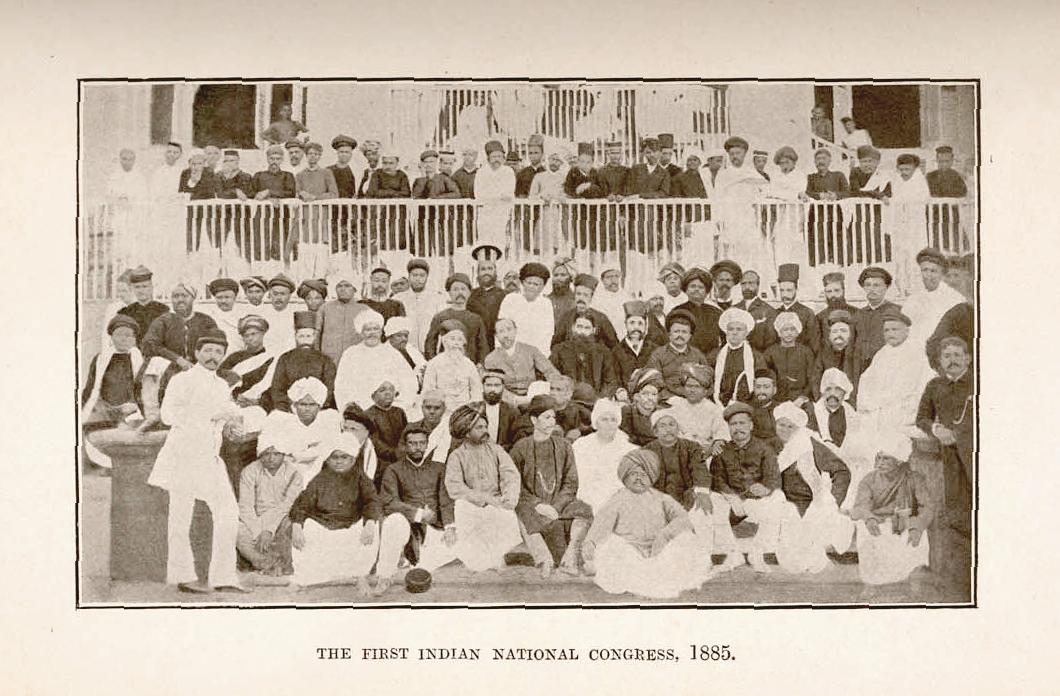
In his presidential address at Lahore, Naoroji called for direct representation in the British parliament from India. He referred to calculations of Indian income and showed how even official calculations substantively conceded his point about the low income in India of Rs 20 per head per annum. He referred to the margin of difference with the official figures thus : " However, Rs 20 or 'not more than Rs 27' – how wretched is the condition of a country of such income, after a hundred years of the most costly administration, and can such a thing last?" Concluding, he reiterated his faith in British fair-play, proposed a session of the Indian National Congress in London, while proclaiming meaningfully: "Our fate and our future are in our own hands." After presiding over the Lahore Congress, Naoroji moved through Kanpur, Agra, Aligarh, and Allahabad to similar acclaim before returning to Bombay.
“The only reason the Indian Government does not go into bankruptcy — bankrupt though it always is — is that it can, by its despotism, squeeze out more and more from the helpless taxpayer, without mercy or without any let or hindrance.”
Naoroji returned to preside over the Congress in the 1906 Calcutta session, when he was sought by both the moderate and extremist sections of the Indian National Congress. His presidential address at Calcutta referred to Swaraj as a goal. There is a vivid description in Patel’s book of the scene at Russa Road, Tollygunge, where this session was held. "As many as twenty thousand individuals, 'crowded to suffocation' gathered to hear the presidential address on December 26, held in an open area on Russa Road in Tollygunge. It was quite likely the largest political gathering held in India to date” (Patel, 245-246). Gokhale read out the bulk of Naoroji's address. In this address Naoroji answered the imperial critics of Indian self-government: “We can never be fit till we actually undertake the work and the responsibility” (Patel, 247).
From royal proclamations and communications made earlier, Naoroji drew out first principles of liberty, equity and justice without which, he argued, the stated objective of "promoting our happiness, etc., etc.," could not be attained. Apart from first principles, he resorted also to legal arguments. He claimed for Indians the rights of British citizens, buttressing his case by referring to an argument based on the "very first territorial acquisition", that of Bombay.
In the charter granted to the East India Company for the island of Bombay the British government had stated: “And it is declared that all persons being His Majesty's subjects inhabiting within the said island and their children and their posterity born within the limits thereof shall be deemed free denizens and natural subjects 'as if living and born in England'.” Naoroji pointed out that “further all the terms of the first grant are extended in it to all future British territorial acquisitions.”
Patel notes that the argument had first been suggested to Naoroji by his old and close India-based associate Behramji Malabari in the midst of the Central Finsbury campaign in 1892. (Patel, 178). In this speech, Patel says, Naoroji made a further advance in this position by demanding reparation for “past sufferings.” Parts of this Calcutta address of 1906 were printed in a journal by the African-American intellectual and campaigner W.E.B. Du Bois, who praised Naoroji's speech as “worthy of men who want to be free” (Patel, 251)
Naoroji went back to England but only to return to India in 1907, this time for good. His wife Gulbai passed away in 1909. In September 1915 he agreed to become President of the Home Rule League set up by Annie Besant. There is considerably more about this matter in Masani (531-32). Naoroji himself passed away on 30 June 1917.
Gradually but surely Naoroji had come to the firm conclusion that robust self-government was the only remedy for the Indian predicament. Naoroji's increased emphasis on the macro-effort for self-government received an impetus from contemporary developments. For example, as Patel points out, the British commitment to restore self-government to the former Boer Republics in southern Africa and the representative government that the United States was willing to offer to the Philippines were a source of encouragement and strength to Naoroji. The message of self-government being the only possible remedy for the country's problems was passed on by Naoroji also to Gokhale.
As Naoroji submitted to the Indian Currency Committee of 1898 (also known as the Fowler Committee):
The only reason the Indian Government does not go into bankruptcy — bankrupt though it always is — is that it can, by its despotism, squeeze out more and more from the helpless taxpayer, without mercy or without any let or hindrance. And if at any time it feels fear at the possible exasperation of the people at the enormity, it quietly borrows and adds to the permanent burden of the people without the slightest compunction or concern. Of course, the Government of India can never become bankrupt till retribution comes and the whole ends in disaster.
A socialist inspiration
Patel refers to Naoroji's attendance of and address at the Amsterdam Socialist Congress in 1904. This is dealt with well in Masani (429-432). But Patel has a fine photograph of the delegates in which Rosa Luxemburg, Karl Kautsky and Henry Hyndman can be seen along with Naoroji. Jean Jaures was also present at the meet. The Anglo-Indian press in India was critical of Naoroji's involvement at the socialist conference.
Indian socialist and communist groups tended, as organisations, to not hearken […] insightful interventions by Naoroji on the rights of labour. But individual socialists continued to refer to Naoroji as an inspiration.
The Grand Old Man repeated his theme about the drain of India's wealth and its connection with the country's poverty. He called for self-government for India and that it be treated on par with the British self-governing colonies. The importance of this first Indian representation at an International Conference of Socialists is self-evident. He defined "working men" as constituting "the immense majority of the people of India".
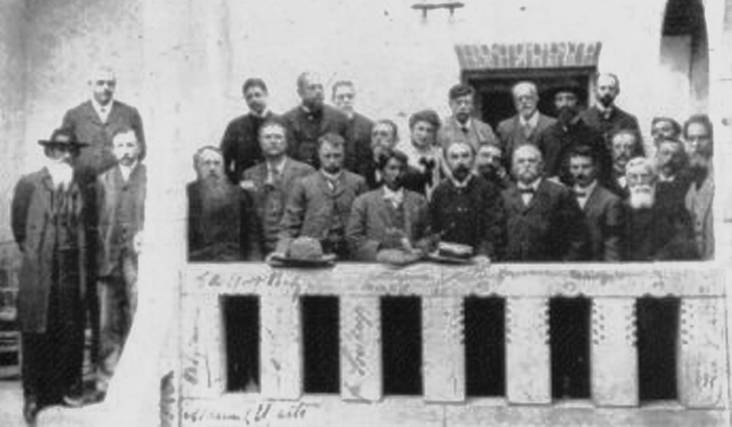
Indian socialist and communist groups tended, as organisations, to not hearken to this and similar insightful interventions by Naoroji on the rights of labour. But individual socialists continued to refer to Naoroji as an inspiration. Brij Mohan Toofan, a socialist freedom fighter born in 1920 in Sialkot (now in Pakistan), recalled that "The first Urdu book I completely read was by Dadabhai [...] It was the village economy, according to him, that was completely ruined. There was an ample record of agrarian distress and almost all the provinces were mentioned by name [....] Perhaps this was the reason for the rise of rural and national movements in India" (Toofan, 110). Jawaharlal Nehru too acknowledged in his autobiography that "Dadabhai Naoroji's Poverty and Un-British Rule in India, and books by Romesh Dutt and William Digby and others, played a revolutionary role in the development of our nationalist thought".
The different emphases between Naoroji and Romesh Chunder Dutt are considered by Patel (234-235). Naoroji emphasised the need to critique the colonial system as a whole rather than focusing merely on the rates of the land tax on the peasantry, as Dutt did. But they agreed on the fundamentals and as Masani pointed out, by 1903 Dutt wrote to Naoroji: "I have never lost a single chance of urging that the drain from India is the cause of her poverty [...] If you were right in combining the land revenue question with the drain question in 1873, I am right in doing the same in 1903".
Conclusions
Pioneer of Indian Nationalism is a book for a wide-ranging readership but especially for Indians. In fact, except for a small point of difference concerning the characterisation of Masani and his biography of Naoroji, there is virtually nothing significant to disagree with Patel. Masani's work is still not replaceable. But Dinyar Patel's book is a worthy companion to it on any bookshelf. It can of course be supplemented on various points.
Pioneer of Indian Nationalism is a creditable effort that is also timely, as it is necessary to be reminded of Dadabhai Naoroji and what he represented.
There is, for instance, the amusing episode in 1911 when the Grand Old Man who inspired India's national struggle was recommended for a knighthood by the governor of Bombay. A knighthood would have added little to Naoroji's stature so far as Indians were concerned and might even have detracted from it. But interestingly, Viceroy Hardinge opposed the move on the ground that Naoroji's granddaughter Perin was connected in Paris to the revolutionary Indian Bhikaiji Cama. 7 Perin, as Perin Captain, would later become president of the Bombay Congress and be jailed, as Patel notes, in the Civil Disobedience movement of 1930. Earlier, during the Non Cooperation Movement of the 1920s, Perin, along with Sarojini Naidu, organised the Rashtriya Stree Sabha. Khurshed Naoroji, another grand daughter of Naoroji (listed in Patel, 328 fn. 22), also left a mark on the Indian struggle, being jailed in the North West Frontier Province in the 1940s and working off and on as Gandhi's secretary. At some stage, 42 years after Dadabhai Naoroji's Amsterdam address, she even threw her lot with the Congress Socialist Party (CSP), eliciting from Gandhi an affectionate note with the response: " You have done well to join the C.S.P." (CWMG 85, 324). At this time the CSP group was still part of the Indian National Congress. Two other Naoroji granddaughters, Gosibehn Captain and Nargisbehn Captain, were also associated with the national struggle, contributing to various aspects of it.
There is a comprehensive note by Patel on the materials available on Naoroji in various archives and collections. The labours of earlier Naoroji scholars like Masani, R. P. Patwardhan and S. R. Mehrotra are well acknowledged. There is also an engaging discussion on documents that went missing and the search that both Mehrotra and Patel made for them.
The index is detailed but not comprehensive. Names such as Thomas Clarkson, the famous anti-abolitionist, and John Howard, the campaigner for prison reform, both of whom according to Naoroji's own account were major influences on him, are missing from the index though not from the text. So also, for example, Arthur Orlebar. There are more references to R.C. Dutt and M.G. Ranade in the text than are mentioned in the index.
Pioneer of Indian Nationalism is a creditable effort that is also timely, as it is necessary to be reminded of Dadabhai Naoroji and what he represented. Especially so, when efforts are afoot to erase historical memories of India's struggle for self-government and Swaraj such that the country itself can be redefined and its people be made to march to different drumbeats.


